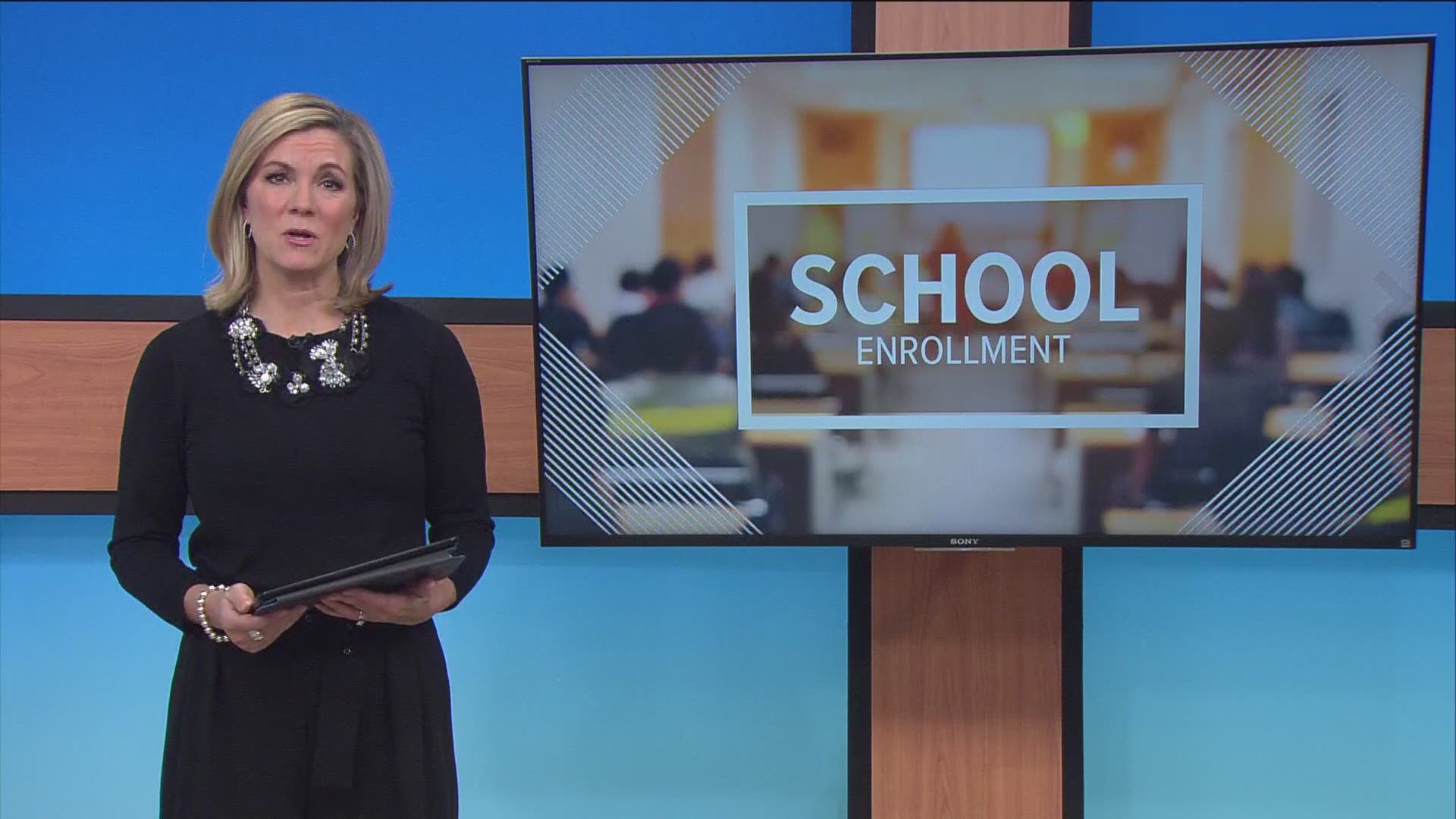ST PAUL, Minn. — Sunday, Feb. 21
- More than 750,000 in Minnesota have received at least one COVID-19 vaccine dose; just over 13% of population
- New cases remain under 1,000, deaths in single digits
- Delayed vaccines arrive in Minnesota after inclement weather, other issues
- Walz: Minnesota passes milestone of 1 million vaccine doses given
- State launches COVID-19 Vaccine Connector to help Minnesotans find shots
- Minneapolis loosens COVID restrictions on bars
The Minnesota Department of Health (MDH) reported 891 new COVID-19 cases Sunday, along with 9 new deaths.
MDH's COVID-19 case definition includes both antigen testing and polymerase chain reaction (PCR) testing. Positive PCR test results are considered confirmed cases, while positive antigen test results are considered probable cases.
Sunday's new case total includes 759 confirmed cases and 132 probable cases.
The total number of Minnesotans who have tested positive for the virus since the pandemic began is now 479,036, with 22,666 of those as antigen test results.
Meanwhile, MDH reported that 754,602 people in the state have received at least one vaccine dose as of Friday. Of that total, 341,332 have received both doses. According to MDH data, a little more than 13% of the state's population has received at least one dose.


MDH says 9 new deaths from the virus were reported. That pushes the total number of fatalities in Minnesota to 6,432.


To date, 25,455 Minnesotans have been hospitalized with the coronavirus since the pandemic started, with 5,258 of them needing care in the ICU.
MDH reports that 465,382 people once diagnosed with the virus have passed the point where they are required to isolate.
Of those who have tested positive, people between the ages of 20-24 account for the most cases with 47,782 cases and three deaths, and ages 25-29 follow with 42,850 cases and six deaths. Those between 85 and 89 years old account for the highest number of fatalities in one age group with 1,220 out of 6,209 diagnosed cases.
In terms of likely exposure to the coronavirus, MDH says 106, cas516es were the result of community transmission with no known contact with an infected person, and 98,437 had known contact with a person who has a confirmed case.
A total of 38,987 cases involved exposure in a congregate living setting,
7,927 were in a corrections setting, and 1,004 were in a homeless shelter. MDH data shows 18,677 were linked to an outbreak outside of congregate living or health care.
MDH says 32,782 cases were linked to travel. Health care workers or patients account for 14,624 diagnosed COVID-19 cases. The source of transmission for 160,082 cases is still unknown or missing.
MDH has prioritized testing for people in congregate care, hospitalized patients and health care workers, which may impact the scale of those numbers. However, now MDH is urging anyone who is symptomatic or even asymptomatic to be tested. Testing locations can be found online.
Hennepin County has had the most COVID activity in the state with 99,347 cases and 1,576 deaths, followed by Ramsey County with 42,602 cases and 794 deaths, Dakota County with 35,610 cases and 383 deaths, and Anoka County with 32,902 cases and 383 deaths.
Full data, including a breakdown of PCR and antigen test totals in some categories, can be found on MDH's website.
Saturday, Feb. 20
Officials said vaccines that were delayed by inclement weather in the Southern US -- then by a misdirected shipment -- have arrived in Minnesota.
According to spokesperson Nick Kimball, the Communications Director with the State of Minnesota's COVID-19 response, 11 delayed boxes of Pfizer vaccine arrived in Minnesota Friday night. Originally, he said the boxes were delayed by inclement weather affecting much of the country. The state received word that the vaccines were on their way Thursday, but found out Friday morning that they had been misdirected and were "on a plane elsewhere."
Kimball said Gov. Tim Walz coordinated with White House officials and the National Guard to locate the shipment, receive it at MSP, then deliver it to vaccination sites to be administered today.
According to the Minnesota Department of Health, 742,760 people in Minnesota have received at least one dose of a COVID-19 vaccine. Out of that total, 315,284 have received both doses. Those numbers, released today, are accurate as of Feb. 18.

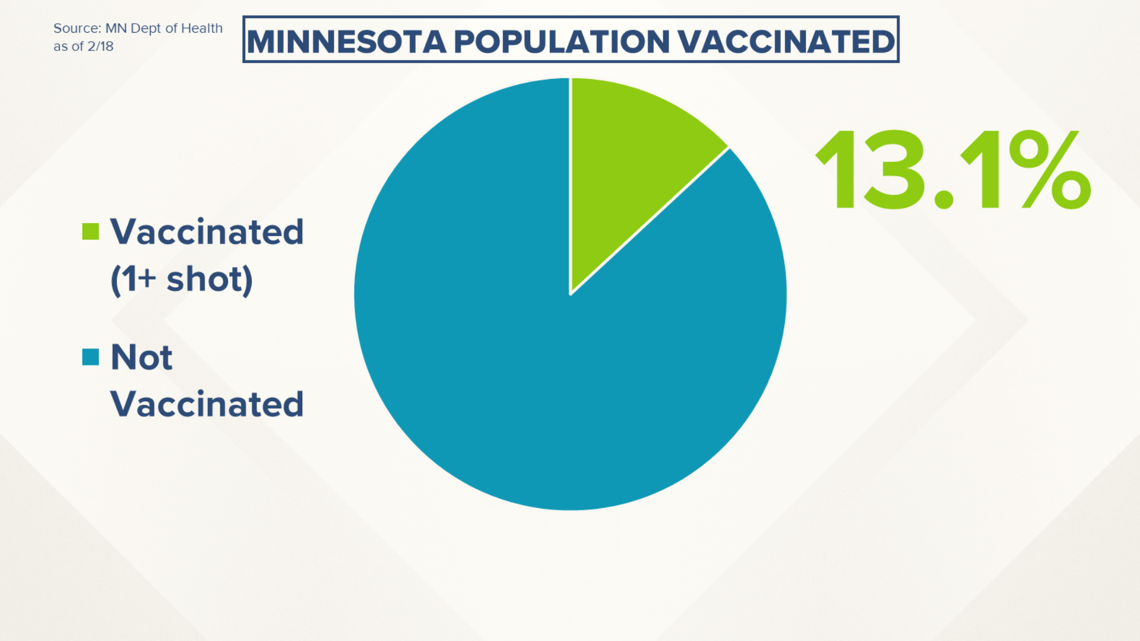
As for other COVID-19 data in Minnesota, MDH reported 884 new cases and 11 new deaths today.
MDH's COVID-19 case definition includes both antigen testing and polymerase chain reaction (PCR) testing. Positive PCR test results are considered confirmed cases, while positive antigen test results are considered probable cases.
Saturday's new case total includes 718 confirmed cases and 166 probable cases.
The total number of Minnesotans who have tested positive for the virus since the pandemic began is now 478,157, with 22,538 of those as antigen test results.
MDH says 11 new deaths from the virus were reported. That pushes the total number of fatalities in Minnesota to 6,423.


To date, 25,426 Minnesotans have been hospitalized with the coronavirus since the pandemic started, with 5,249 of them needing care in the ICU.
MDH reports that 464,504 people once diagnosed with the virus have passed the point where they are required to isolate.
Of those who have tested positive, people between the ages of 20-24 account for the most cases with 47,716 cases and three deaths, and ages 25-29 follow with 42,796 cases and six deaths. Those between 85 and 89 years old account for the highest number of fatalities in one age group with 1,220 out of 6,206 diagnosed cases.
In terms of likely exposure to the coronavirus, MDH says 106,237 cases were the result of community transmission with no known contact with an infected person, and 98,213 had known contact with a person who has a confirmed case.
A total of 38,954 cases involved exposure in a congregate living setting,
7,922 were in a corrections setting, and 1,002 were in a homeless shelter. MDH data shows 18,592 were linked to an outbreak outside of congregate living or health care.
MDH says 32,726 cases were linked to travel. Health care workers or patients account for 14,615 diagnosed COVID-19 cases. The source of transmission for 159,896 cases is still unknown or missing.
MDH has prioritized testing for people in congregate care, hospitalized patients and health care workers, which may impact the scale of those numbers. However, now MDH is urging anyone who is symptomatic or even asymptomatic to be tested. Testing locations can be found online.
Hennepin County has had the most COVID activity in the state with 99,189 cases and 1,576 deaths, followed by Ramsey County with 42,534 cases and 794 deaths, Dakota County with 35,532 cases and 382 deaths, and Anoka County with 32,859 cases and 382 deaths.
Full data, including a breakdown of PCR and antigen test totals in some categories, can be found on MDH's website.
Friday, Feb. 19
11 a.m.
For the first time in a week, new COVID-19 case numbers in Minnesota have nudged back over the 1,000 mark.
Data released Friday by the Minnesota Department of Health (MDH) says 1,001 cases were diagnosed in the past day based on 45,367 tests (39,633 PCR, 5,734 antigen) processed in private and state labs. Health officials consider a positive PCR test a confirmed COVID case, while a positive antigen case is considered a probable case.
Minnesota has now recorded 477,287 coronavirus cases since the start of the pandemic, 22,377 of which are based on antigen tests.
Eight more people have died of the virus, bringing total fatalities in the state to 6,412.
Hospitalizations remain under 300, with 282 people being treated on an in-patient basis as of Thursday. Of those patients, 59 are in ICU. Open beds at Twin Cities hospitals remain low with just 110 non-ICU beds available. That's a vacancy rate of just 3%.
Total hospitalizations across the state now stand at 25,368 since the pandemic began.

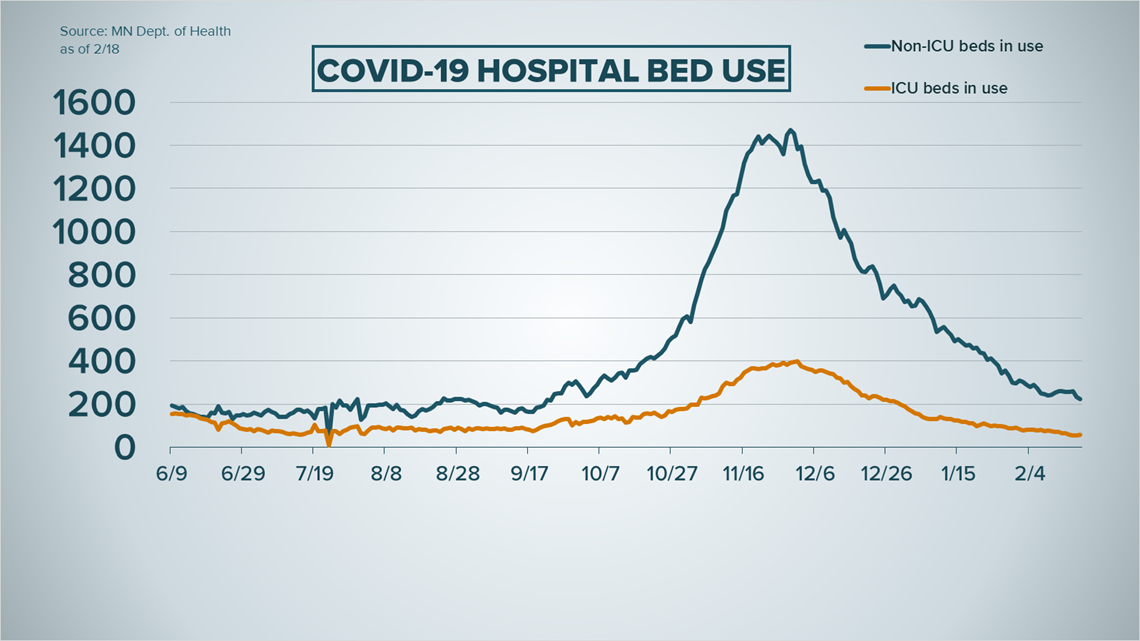
MDH says 463,454 people diagnosed with the virus at one time have passed the point where they require isolation.
As noted earlier Minnesota has passed a milestone with more than 1 million doses of COVID-19 vaccine administered. The state vaccine dashboard says as of Wednesday 728,081 people have received at least one dose, 13.1% of the population. Of those people, 286,543 have completed the two-shot immunization series.

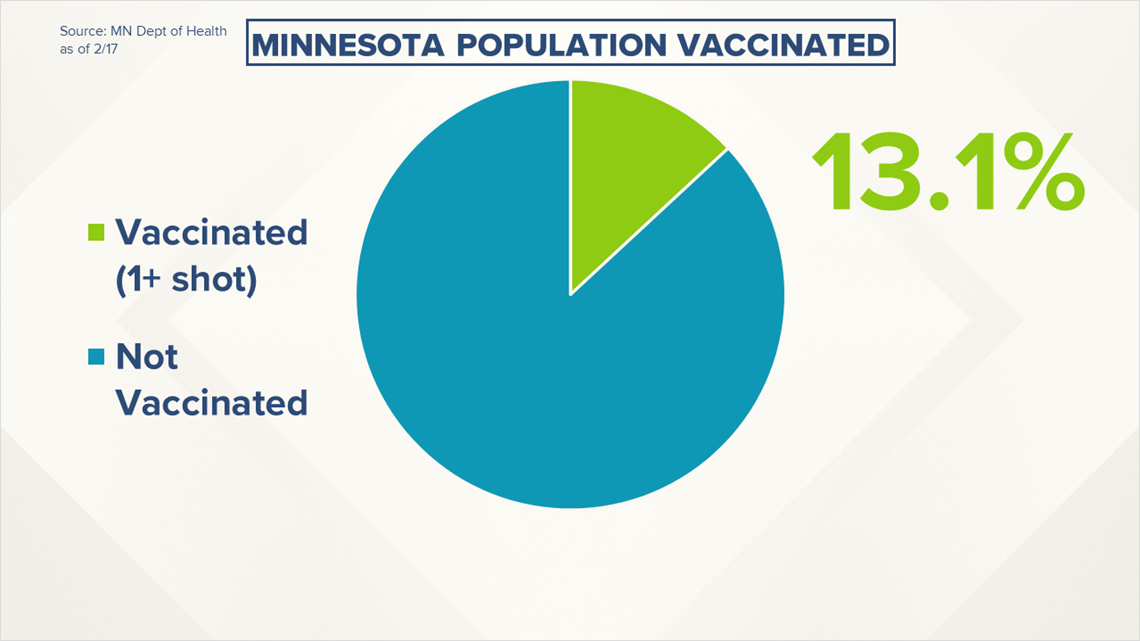
Governor Walz says the state is currently averaging nearly 30,000 doses administered per day. That could dip in the next few days with a break in the vaccine supply chain caused by winter storms in the southern U.S.
Young adults ages 20 to 24 continue to account for the largest number of Minnesota's cases with 47,650 and three deaths, followed by those 25 to 29 with 42,736 cases and six deaths. The largest grouping of fatalities involves 85 to 89-year-olds, with 1,218 deaths in 6,194 cases.
Hennepin County has recorded the highest volume of COVID activity with 99,020 cases and 1,576 deaths, followed by Ramsey County with 42,468 cases and 792 deaths, Dakota County with 35,459 cases and 381 deaths, and Anoka County with 32,775 cases and 382 fatalities.
Cook County is the state's COVID quiet spot, with just 119 cases and zero deaths.

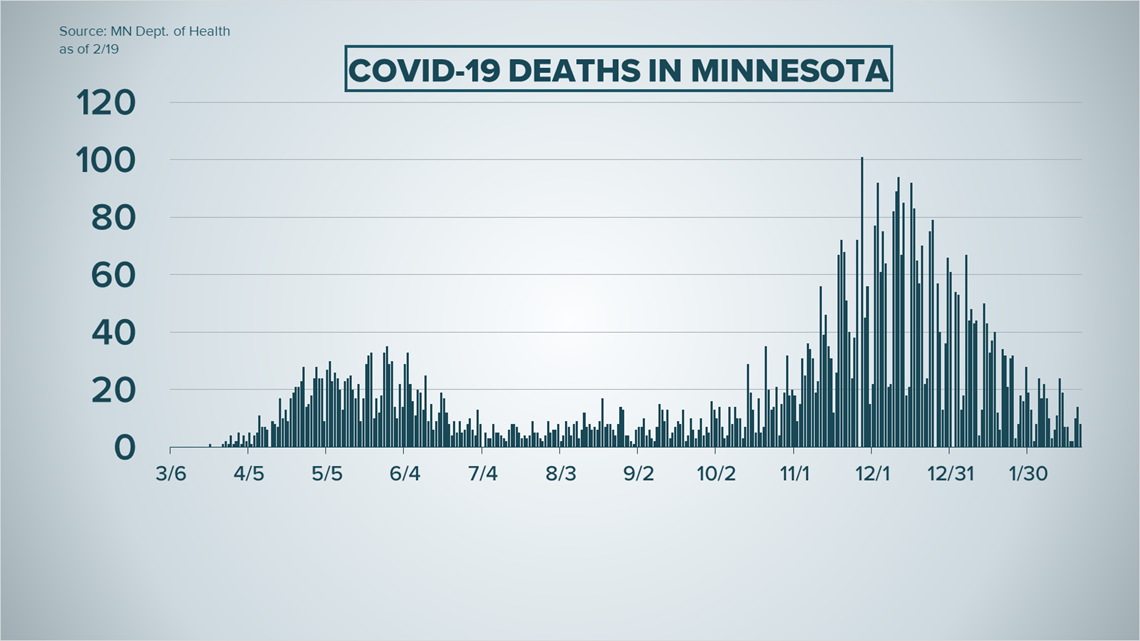
9 a.m.
Minnesota has passed a milestone in the battle to vaccinate residents and turn back COVID-19, but there is still a long way to go.
Governor Tim Walz announced Friday that the state has administered more than one million doses of the COVID vaccine (1,016,210 if you're counting). The official state report says 286,543 have completed the two-shot series. The seven-day rolling average for vaccinations across Minnesota is now 29,705.

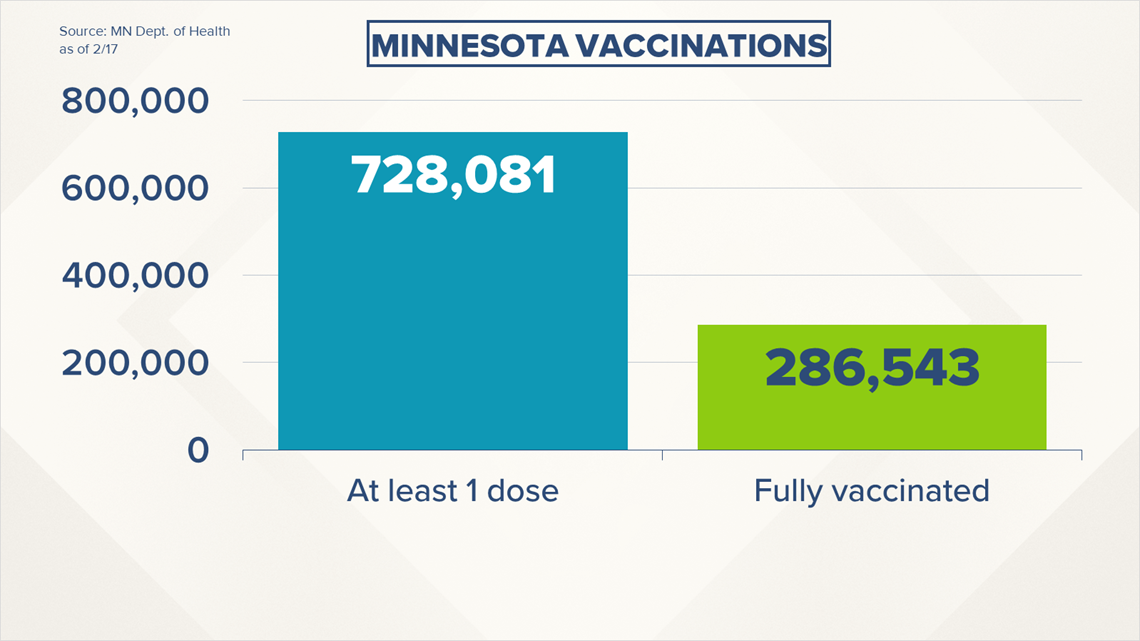
“This is a milestone day. Minnesotans have received 1 million doses of these safe, effective, live-saving vaccines,” Walz said in a released statement noting the milestone. “Every time a Minnesotan gets their shot, they are protecting themselves and moving our entire state closer to ending this pandemic. We still need more vaccine from the federal government and we have a long road ahead, but we can truly see the light at the end of the tunnel.”
Minnesota is currently immunizing people in top priority groups, including those with health conditions, long-term care residents, people ages 65 and up, front line workers, first responders, and K-12 educators and child care providers, among others.
Other groups will be targeted once the federal government increases supplies of vaccine for Minnesota. The state yesterday unveiled its COVID-19 Vaccine Connector program, which will inform those who sign up when they are eligible to be vaccinated, and steer them to places near them where doses are available.
Thursday, Feb. 18
2:20 p.m.
The Minnesota Department of Health (MDH) is reporting that COVID-19 vaccination appointments were postponed in two community locations for Thursday Feb. 18, and in six locations for Friday, Feb. 19 after severe winter weather in the U.S. delayed vaccine shipments.
MDH warned that additional shipping delays caused by the storm system could cause "significant operational challenges" for both state sites and other providers in coming days.
Among them are the state-run community vaccination locations in St. Cloud, Rochester (Willow Creek), Fergus Falls, North Mankato, Thief River Falls and Minneapolis. MDH says patients at these locations with appointments on February 18 and 19 are being notified that their appointments are postponed, and will be contacted 24-48 hours from their postponement notice about rescheduling vaccinations as soon as possible.
The department is in close contact with the CDC to monitor the vaccine delays, and is updating providers with new information that includes shipping details and ways to track doses leaving warehouses.
2 p.m.
The city of Minneapolis is aligning with the state of Minnesota and loosening some restrictions on bars and restaurants.
Mayor Jacob Frey issued a statement Thursday saying that bars can resume counter service, as long as establishments continue to follow state guidelines around restaurant precautions and capacity.
Effective Thursday, Frey's emergency regulation that was issued to limit bars and restaurants is rescinded. That is the order that was prohibiting bars from serving drinks at the bar area, and required customers to be served while seated at tables.
In his announcement, Frey cited the low level of cases in Minnesota, the stabilized hospitalizations rates and the "ramping up" of vaccination efforts.
11 a.m.
The state of Minnesota is nearing a benchmark in its efforts to vaccinate against COVID-19, but state officials emphasize there is a long road ahead before every resident is considered safe.
Data from the state's vaccination dashboard show that 710,305 people have received at least one dose of vaccine, with 264,122 of them having completed the two-shot series. That means as of Thursday, 974,427 doses have been administered, making it very likely that the 1 million mark will be eclipsed in Friday's report.
The dashboard says 12.8% of Minnesota's reported 5.6 million residents have now received at least a first dose, but Department of Health Commissioner Jan Malcolm reminds state residents this will be a long process. Malcolm says at this point Minnesota is receiving 88,000 doses of vaccine from the federal government each week, less than 1% of what we actually need to do the job. She also cautioned that vaccination numbers will likely be down in the coming days, due to distribution of supplies being impacted by the huge winter storm in the southern U.S.
On Thursday afternoon MDH reported that appointments were postponed in two community locations for Feb. 18, and in six locations for Feb. 19. The department warned that additional shipping delays caused by the winter storm system could cause "significant operational challenges" for both state sites and other providers.
MDH promised to stay in touch with those who have appointments canceled to work on rescheduling.

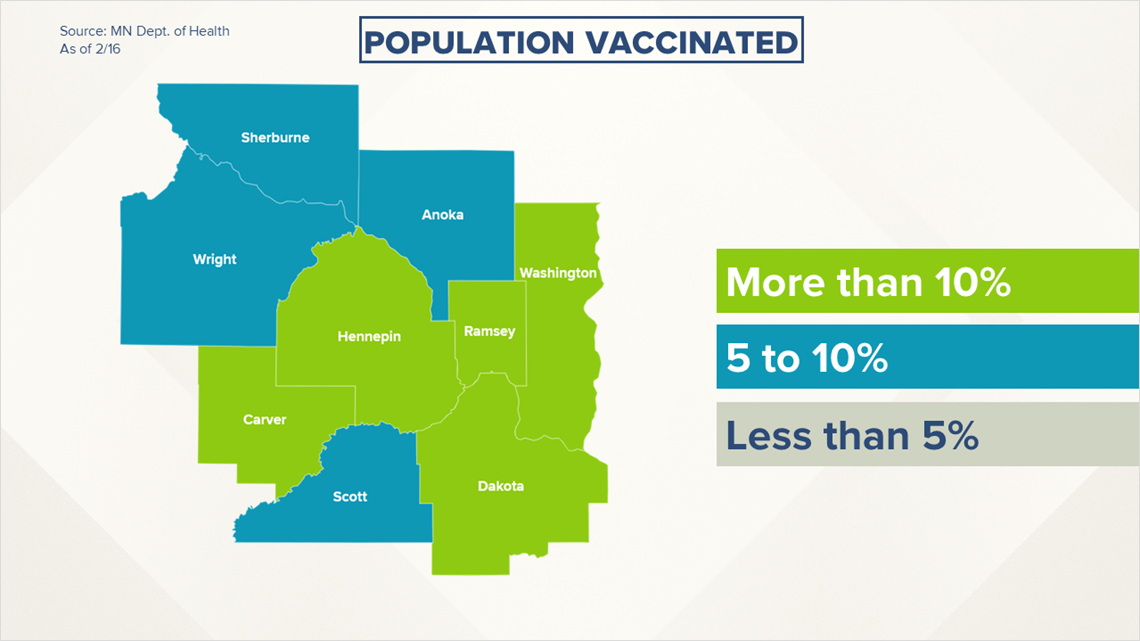
As far as new cases go, the Minnesota Department of Health (MDH) says 928 were recorded in the last day, an uptick that is against recent overall trends. Those new cases are based on results from 33,915 tests (31,198 PCR, 2,717 antigen) processed in private and state labs. That brings total COVID cases in the state to 476,292 since the start of the pandemic, 22,207 of which were tied to antigen tests.

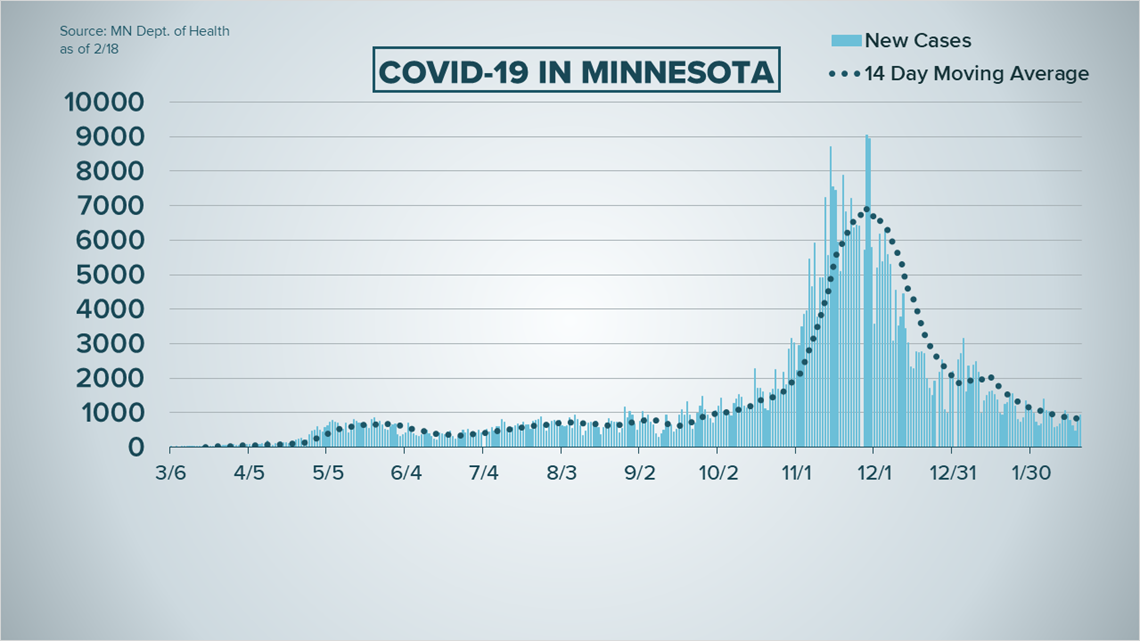
MDH says 14 more people have died of coronavirus, pushing fatalities over the 6,400 mark (6,404). Of those deaths 4,027, or 63%, are linked to long-term care or assisted living settings.
The number of people currently hospitalized in Minnesota as of Thursday is 287, the first time in months that count has dropped below 300. Of those patients 54 are being cared for in the ICU. Bed availability in hospitals across the Twin Cities is low, with just 3% (111) of non-ICU beds being open for patients.
Total hospitalizations have risen to 25,341, with 5,230 of those patients requiring treatment in the ICU.

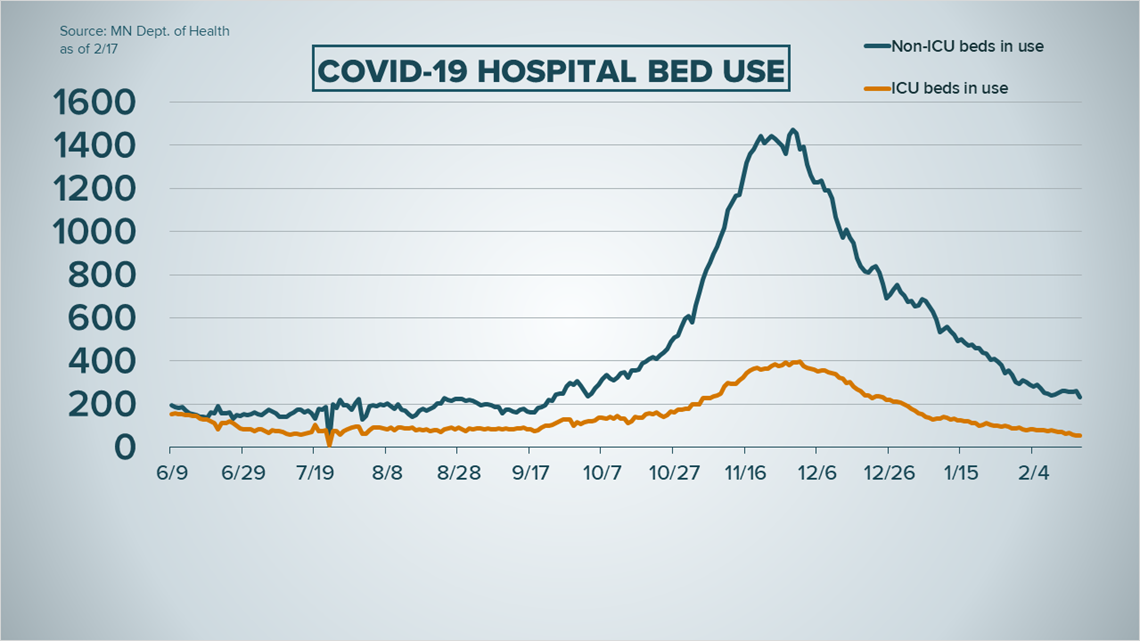
Of the Minnesotans who have tested positive for the virus, 463,041 have recovered to the point they no longer need to isolate.
Young adults between ages 20 and 29 account for 90,238 of Minnesota's COVID cases, just short of 20 percent of the state's total. Nine people from that age demographic have died from the virus. Those 85 to 89 have recorded the largest number of deaths, with 1,215 in just 6,184 cases.
Cook County in northeastern Minnesota reports the least COVID activity with just 118 cases since the pandemic began, and no one there has died of the virus. Hennepin County has recorded the most COVID activity with 98,828 cases and 1,576 deaths, followed by Ramsey County with 42,376 cases and 790 deaths, Dakota County with 35,365 cases and 380 deaths, and Anoka County with 32,718 cases and 380 fatalities.
10 a.m.
The state is taking the wraps off a new tool that will help all Minnesotans find out when, where, and how to get their doses of the COVID-19 vaccine.
Governor Tim Walz calls the COVID-19 Vaccine Connector the next step in the state's strategy "to meet Minnesotans where they are and connect them to vaccine opportunities, no matter where they live or their personal circumstances."
In an online briefing with reporters, Minnesota Department of Health Commissioner Jan Malcolm urged all Minnesotans who have not yet received their vaccine to sign up, either via the state's COVID-19 response web page, or by calling 833-431-2053 for those without computer access or those who need assistance. She called the new tool "a really important step in our overall strategy."
"This is going to be a really great tool to help all Minnesotans no matter who we are, what eligibility category we are in, when we anticipate getting vaccinated, this tool is available to all of us, right now, to help us better identify when, where and how we will be able to get our COVID-19 vaccine," Malcolm explained.
There is no cost, and no restricted time period for registering.
Malcolm said Minnesota is currently receiving about 88,000 doses of vaccine per week from the federal government as our share of the national disbursement, saying that number is about 1% of what the state actually needs each week to vaccinate all its residents.
The commissioner also noted Thursday's revelation that America's life expectancy rate has dropped by a full year, in large part due to the COVID-19 pandemic, but said certain populations (people of color, Native Americans) are impacted by a rate two to three times higher.
Malcom believes that the COVID-19 Vaccine Connector can help those populations get into the system easily, so they are not left unvaccinated and vulnerable.
Those signing up will be asked to provide contact information, demographic data, medical history, and employment to determine their eligibility for vaccinations. The online form includes questions about gender identity, sexual orientation, race, cultural identification, and disabilities to help health officials track and measure the equity and fairness of the vaccine distribution process. These questions have the option of selecting “prefer not to answer” or “none of the above,” and opting to not answer will not prevent a person from signing up.
Anyone who registers will be alerted by the Vaccine Connector when they become eligible to be vaccinated under state guidelines. It will then help with connecting them to resources to schedule an appointment, or notify that person if there are other vaccination opportunities in their area.
Actual appointments will be made through a registered provider.
State IT Commissioner Tarek Tomes said as of 10 a.m. 50,000 people had already signed up for the vaccine connector, but he insists it's about more than the volume of users. "This tool has larger longer-term implications for the state's COVID-19 response effort, as it connects Minnesotans with the many vaccine provider opportunities throughout the state," he explained.
In the current phase of its vaccination strategy Minnesota is providing doses for health care workers, long-term care residents, pre-kindergarten through grade 12 educators, child care workers and people age 65 and over. State leaders are urging all Minnesotans who have not been vaccinated to sign up for the Vaccine Connector. Residents will also continue to hear about vaccination opportunities in other ways:
- Health care personnel will hear from their employer about when and where they can get vaccinated
- Long-term care residents will hear from their facility about when and where they can get vaccinated
- Adults 65+ who already registered through either the COVID-19 Vaccine Pilot Program or the COVID-19 Community Vaccination Program do not need to re-submit information. When adults 65+ sign up for the Vaccine Connector, they will immediately be entered into the random selection process for the state’s Community Vaccination Program sites operating in Minneapolis, Duluth, and Rochester. If they are selected to receive their vaccine at one of these sites, they will be notified by text, email, or landline by the company that runs those sites, Vault Health.
- The state is continuing to partner with hundreds of local medical providers and pharmacies to provide shots to Minnesotans age 65 and older. Adults 65+ can use the Vaccine Locator map to find nearby vaccine distribution sites and make an appointment to receive a vaccine through the providers listed there. They can also contact their regular provider directly.
- Educators and child care providers who already completed the Minnesota COVID-19 Vaccine – Education and Child Care survey do not need to complete the Vaccine Connector form, or re-submit their information. Educators, school staff, and child care workers will continue to hear from their local public health agency, employer, state-sponsored community vaccination site, or state vaccination partner about when and where they can get vaccinated.
KARE 11’s coverage of the coronavirus is rooted in Facts, not Fear. Visit kare11.com/coronavirus for comprehensive coverage, and kare11.com/vaccine for answers to all of your questions about vaccines. Have a question? Text it to us at 763-797-7215. And get the latest coronavirus updates sent right to your inbox every morning. Subscribe to the KARE 11 Sunrise newsletter here. Help local families in need: www.kare11.com/give11.
The state of Minnesota has set up a data portal online at mn.gov/covid19.

